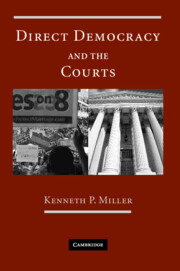Book contents
- Frontmatter
- Contents
- List of Tables and Figures
- Preface
- Introduction: A Clash of Rising Powers
- PART I THE QUEST FOR MAJORITY RULE
- PART II COUNTERING THE MAJORITY
- PART III THE MAJORITY STRIKES BACK
- 7 The People's Check on the Courts
- Conclusion: A New Constitutional Equilibrium
- Appendix: Post-Election Initiative Invalidations
- References
- Index
- References
7 - The People's Check on the Courts
Published online by Cambridge University Press: 05 June 2012
- Frontmatter
- Contents
- List of Tables and Figures
- Preface
- Introduction: A Clash of Rising Powers
- PART I THE QUEST FOR MAJORITY RULE
- PART II COUNTERING THE MAJORITY
- PART III THE MAJORITY STRIKES BACK
- 7 The People's Check on the Courts
- Conclusion: A New Constitutional Equilibrium
- Appendix: Post-Election Initiative Invalidations
- References
- Index
- References
Summary
Fear of judicial tyranny can be traced back to the founding when the Anti-Federalist Brutus warned that the Constitution made federal judges “independent in the fullest sense of the word…independent of the people, of the legislature, and of every power under heaven.” Unaccountable judges, Brutus predicted, would exercise power “to the oppression of the people.” This prophecy remained largely unfulfilled until the Lochner era when the rising judicial power more aggressively asserted its will, often at the expense of popular majorities. A long series of conflicts caused many reformers to conclude that courts were out of control and needed to be constrained.
This chapter analyzes various attempts to counter the courts, especially at the state level, over the past century. The Progressives had limited success placing explicit constraints on judicial power, but some democratic devices, including initiative constitutional amendment (ICA) and judicial elections, have provided the people at least a partial check on activist judges.
THE PROGRESSIVE ERA COURT CRISIS
The Progressive Era conflict over judicial power is less well known than the later New Deal crisis, but it produced intense political controversy and was at the heart of the debate over the adoption of direct democracy. It was during the Progressive Era that the U.S. Supreme Court decided Lochner v. New York (1905), the case that came to symbolize the first wave of judicial activism. Lochner was a challenge to an 1895 New York statute known as the “bake-shop law.”
- Type
- Chapter
- Information
- Direct Democracy and the Courts , pp. 189 - 215Publisher: Cambridge University PressPrint publication year: 2009



